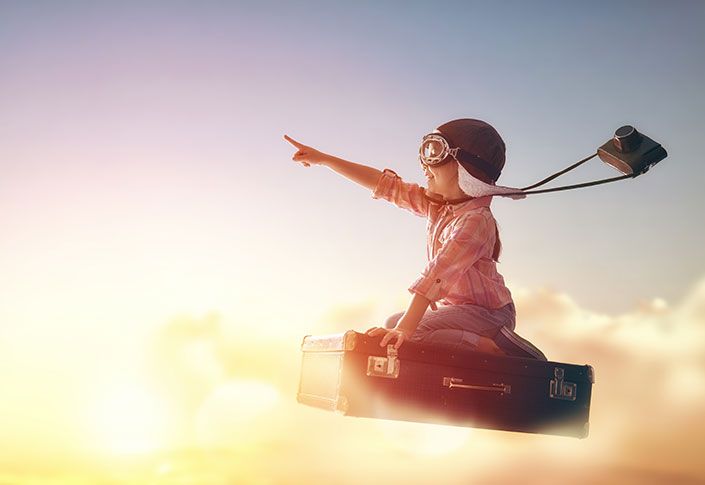Where travel agents earn, learn and save!
News / Daydreaming about travel can help us all
“Everything starts as somebody’s daydream.” Larry Niven

May 12 - The importance of daydreaming during the current COVID19 pandemic with closed borders and nations in strict lockdown is evident once you switch on the TV or scroll through your Insta-feed full of dreamy destinations.
It is a smart marketing strategy embraced by a host of brands, tour operators, airlines, and many others as hashtags such as #StayHome, #TogetherInTravel, and #TravelTomorrow are trending online.
Feeding one’s imagination during this quarantine with alluring destination shots, virtual tours of museums, and free online theatrical experiences, not only is motivational and much needed for mental health, but great for daydreaming.
The Beauty of Daydreaming
According to the US scholar, Jonathan Gottschall, the average daydream is about fourteen seconds long and we have about two thousand of them per day. In other words, we spend about half of our waking hours, one-third of our lives on Earth spinning fantasies.Therefore, “spinning fantasies” takes up a lot of our time, but all is not wasted on unrealistic dreams. It has its merits too.
In 2012, a team of researchers at the University of California at Santa Barbara conducted an experiment and asked 145 participants to perform what’s called an “unusual uses task,” which is a test that for decades has been successfully utilized to measure degrees of creative problem-solving. It involves presenting participants with a common object, like a bottle, and then giving them a limited amount of time to list as many uses as they can think of for that object. The participants’ performance is then scored based on the uniqueness of the answers.
The participants were then split up into four groups with varying breaks and cognitive demands. They discovered that participants who did more mind wandering aka “daydreaming” got more creative on the repeated unusual uses tasks; they came up with more creative solutions to the problems presented to them after they had some time to let their brains chew on them, so to speak.
So, daydreaming has been proven to lead to increased creativity and productivity leading to solution making. Not bad, right? This is something very powerful to factor in the present global climate of travel restrictions.
The Three Phases of the Travel Customer Journey
It comes as no surprise then that in the recent analysis ForwardKeys conducted comparing the breakdown of flight searches per quarters in 2019 to 2020, holiday plans are still on the agenda, albeit deferred to a later period due to the current socio-political restrictions.Three of the most Coronavirus impacted nations were placed under the microscope: Italy, Spain, and France, and guess what? Despite the tight government regulations limiting their current physical movement and self-isolation, despite all the health concerns – the citizens in each country are searching Skyscanner for long-haul flights in Q3 and Q4.
This is not only a nice bit of fresh air for those tired of pessimistic forecasts for travel and the economies of those dependent on tourism dollars, but demonstrative of the value that daydreaming has on business outcomes.
Technology has revolutionized the way people research, plan, and book their travel experiences. Today’s customers use the internet on almost every stage of their travel journey, from deciding where they want to go to share photos from their vacation on social media once their home.
In fact, Google has broken the travel customer journey up into three crucial stages: dreaming, planning, and booking. See, dreamers do have an important role in the travel consumer journey after all and are not to be dismissed as prospective customers.
Inside the Head of a Daydreamer
The Dream stage happens after the travel bug has bitten but before any concrete decisions have been made. It is that feeling of “I want to get away” or “I’m ready to take that big trip I’ve always dreamt about.” The customer might not know where they want to go or what they want to do once they are there. They just know they want to go.This stage is heavy on the fantasizing and light on the practicalities. Travellers are open in this stage, looking anywhere and everywhere for that one thing that will inspire them to plan a trip. They are likely doing lots of Googling, conducting countless image or map searches, looking at travel websites like Travel & Leisure, Booking.Com or TripAdvisor, and browsing on social media.
These potential customers will be searching for things like “best places to go in the Summer” or “the Best Cities to Visit in 2020” or “the cheapest beach towns in Mexico.”
They are not yet interested in logistics like flights, transportations, or hotels. What comes next in the planning stage. This will happen eventually, once the travel bans are lifted, international flights are made available and the all-clear regarding health and safety has been given by national and international governing bodies.
With the latter most likely to take place at some yet unknown point this year, the best one can do right now is to continue to search and dream of white, sandy beaches and poolside mimosas.
Just remember, everything starts as somebody’s daydream. Daydreamers lead to actions.
More Travel News:
UNWTO latest dashboard for COVID-19
WTM Global Hub: LIVE webinar – Airlines in Crisis
G Adventures founder, Bruce Poon Tip’s lockdown ‘instabook’ for travellers
The World’s Top 10 Airports of 2020












